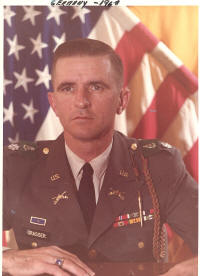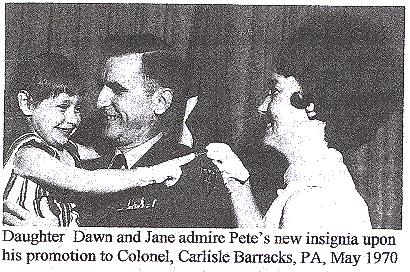|
The Faces Behind the Names,
the Men Behind the Mugs: A Chance to Live Forever - Thru Cold War
Beer Steins
A friend of mine is a
passionate collector of antique German beer steins, this led to an
interest in old American steins and mugs and finally to the Cold War
beer steins that many American servicemen took home as souvenirs in
the 1950s thru 1970s. From this last type, he has over 300 Army,
Air Force and Navy examples and while you and I might be in awe of
that number, among Cold War stein collectors, 300 would be
considered a nice assembly but hardly the largest collection known.
E Bay is a prime source
but other steins are found at breweriana shows, at specialty
auctions and gathered thru private sales and trades between
collectors. Every now and then, he even finds one at an estate
sale.
Prices seem to vary - at
the low end, a 1970s vintage stein on E Bay goes for about $50.00;
the most expensive Cold War stein sold on Bay was a very early
Special Forces / city of Bad Tolz lidded beer mug - $900.00.
I asked him to go thru
his collection for steins related to Bad Kissingen, it took him a
while, so much porcelain, so many shelves but eventually he came up
with three steins that troopers had taken home from Daley Barracks
as commemoratives of their tours.
These decorative mugs had
probably sat in cabinets, on desks or packed away in dusty attics
for decades and then, as is apt to happen, when an estate is settled
and the physical stuff that helped illustrate a life must be sorted
out - some few items remain with family members, a lot of things are
given to charity or go to the land fill and a few things end up,
turned to cash - on the market. If you are of the age where you
have helped clear out the household of a parent - you know what I
mean.
So here we consider the
careers and lives of military men we never knew and it seems fitting
that beer - or at least beer steins are involved. The connecting
links are Daley Barracks and Bad Kissingen, the border and the Army,
the drumbeat of duty, tanks, training and men. Here are physical
reminders from a tour of duty in an armored cavalry unit, a passing
remark that our deeds seldom outlive our days and a brief note that
a porcelain beer stein and a name written in gold does offer a
fraction of immortality.
As long as they read your
name - you never quite fade away and may in fact become collectable
- except in the digital age - where names live forever as files and
fragments that are occasionally saved and often deleted.
Peter Grasser
Peter George Grasser was
born 25 February, 1929 in Wilkinsburg, PA to parents who had
immigrated to the United States from Germany and Austria. He
attended Greenbrier
Military Academy in West Virginia from
middle school thru his first year in college and then enlisted
into the Army thru the Officer Candidate School Program.
| |
Click on the thumbnail to view the
full-sized picture |
|
| |
 |
|
 |
|
| |
Cadet Grasser at Greenbrier in 1946. The school closed in 1972, the
campus is now home to an Osteopathic Medical College. |
|
Lt Grasser shortly after OCS graduation. |
|
He was commissioned in
1949, completed the Armor Officer Basic course at Knox and reported
for duty with the Second Battalion of the 14th Armored
Reconnaissance Regiment in Germany the following year. Initially
located at Schweinfurt, he was with the unit when it moved to Bad
Kissingen and served as a platoon leader, staff and executive
officer until July 1953.
| |
Click on the thumbnail to view the
full-sized picture |
|
| |
 |
|
 |
|
| |
Three views of Lt Grasserís souvenir beer stein from his first troop
leading assignment in Germany. The design is quite typical for
these steins, the unit crest at the front, side panels display the
Constabulary emblem the 14th Cav wore until 1952 and the City Seal
of Bad Kissingen. |
|
Photos from the 1952 14th Armored Cavalry yearbook were not
captioned - the back of the book did contain unit troop lists and Lt
Grasserís name is present in the Company D file. Colonel Grasserís
wife and daughter believe the officer seated at center is Lt
Grasser. |
|
Over the next ten
years, he was assigned to the 30th Tank Battalion at Knox
initially as C Company XO followed by command of that unit,
a stint as battalion S3 and then command of Company B, 83 rd
Recon Battalion.
Transferred to
the 709th Tank Battalion, he commanded B Company, was again
S3 and accompanied the unit when it moved to Germany. Here,
he served as the Assistant Operations Officer of Combat
Command A, part of the 3rd Armored Division. He was
integrated into the Regular Army as a Captain in 1958 and
returned stateside in 1959.
The next decade of
Captain Grasserís life unfolded at a frantic pace. Highlights
included graduation from the Command and General Staff College at
Fort Leavenworth and the Army War College at Carlisle Barracks. He
was published
in Armor Magazine in an article discussing the evolution of
armored recon forces and it is amazing to read just how much
technology he envisioned in the early 1960s that ultimately came to
pass decades later.
| |
Click on the thumbnail to view the
full-sized picture |
|
| |
 |
|
| |
LTC Grasser in command in the late 1960s. |
|
On the civilian
side, he completed his undergraduate degree at the
University of Omaha and received a Master of Arts graduate
degree from George Washington University. Significant
military assignments included senior staff positions at Fort
Knox, the Pentagon and command of the 4th Battalion, 35th
Armor, part of the 4th Armored Division in Germany.
He turned up in the
newspapers - Stars and Stripes reported on his innovative program
aimed at increasing soldier safety. As troopers from his battalion
signed out on leave, no soldier could depart without battalion
maintenance conducting a thorough inspection of his privately owned
auto.
In Vietnam, he served as
both the G1, personnel officer and then G3, operations officer, for
the 25th Infantry Division.
| |
 |
|
| |
The newly promoted Colonel Grasser with wife and child. |
|
In the 1970s and final
decade of his career, Colonel Grasser served a second assignment at
the Pentagon working on force development, commanded the 1st Bde,
2nd Infantry Division in Korea and ended his Army career as the
Director of the Weapons Department, the Armor School, Fort Knox KY
with retirement in 1976.
I missed overlapping my career with Colonel
Grasser by a single year; we otherwise might have met at the PX and
were we standing in line to pay for our items, I would like to
believe that Col Grasser would have seen the Blackhorse patch on my
shoulder and might have paused to remark. An occasion to recall so
many years back and how units and duty stations change and then
consider a new Lieutenant and where he was going and where he once
was.
His family recalled that
Colonel Grasser loved the Army and the ideals of service
tremendously and he enjoyed being in command - something he was
frequently chosen to do. They declined to provide much information
as to his post Army endeavors beyond that he continued to live in
Kentucky and was survived by his wife of 35 years and one adult
daughter. Colonel Grasser is also recalled as a Significant
Graduate at the
museum associated with the former Greenbrier Military Academy. |

